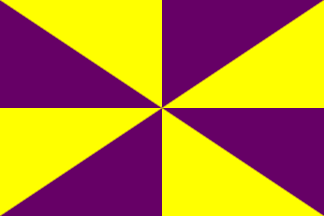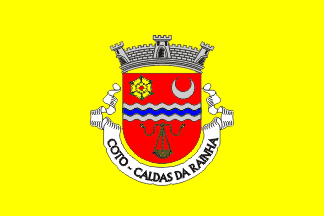
Last modified: 2014-06-29 by klaus-michael schneider
Keywords: caldas da rainha | coat of arms: bordure | shrimp catcher | pelican (golden) | crown: open | coto | crescent: pints up | rose (yellow) | waves: 3 |
Links: FOTW homepage |
search |
disclaimer and copyright |
write us |
mirrors

It is an atypical portuguese municipal flag, with the
coat of arms centered
on a purple and yellow gyronny
(city rank) background.
The existence of a tradition of atypical (and
“illegal”)
representations may account for the fact that this coat of arms and flag are
not yet made official, though they are in use for many decades.
António Martins, 21 Mar 2007
.gif)
The arms are those of Leonor de Viseu (1458-1525) as Queen-Consort of Portugal (1481-1495): per pale Portugal and Portugal defaced with a chief of Aragon and Two Sicilies. Flanking the shield two smaller shields argent bearing this queen’s and her husband’s badges Or: a pelican in her piety dexter (John II) and a shrimp-catcher.
The usual representations of these arms, both as the queen’s and the city’s, are simplified to have only one single file of castles on the central part of the conjoined borders, the whole arms being discribed as Argent between two crosses of five escutcheons each charged with five plates per saltire a pale Gules charged with five castles Or and on a bordure Gules ten castles Or (etc.) with the aragon chief reduced to a fesslet couped fretty Sable and Argent.
António Martins, 21 Mar 2007

Plain (monocolored) portuguese subnational flags are
not allowed to have armless
variations: plain flags always carry the coat of arms.
Jorge Candeias, 18 Jul 1999
Caldas da Rainha municipality had 51 403 inhabitants in 2001 and
consists of 16 communes covering 255,87 km². It is part of
Leiria District, traditional province
Estremadura, 1999 ref. adm. region Ribatejo e Oeste,
C.C.R. / NUTS II Centro, and NUTS III Oeste.
António Martins, 21 Mar 2007
"Caldas da rainha" means "queen’s spa" (or "queen’s
bath") and the arms are not just canting about her,
they’re her arms: Caldas da Rainha was chosen by this
queen to build a thermal hospital, which is still open.
António Martins, 21 Mar 2007 and 22 Mar 2007

It is a fairly typical portuguese communal flag, with the
coat of arms centered on a
plain yellow background.
Flag and arms adopted and published in the official journal
Diário da República : III Série in 2000.04.28.
The banner should have
golden and red tassels and cord, and golden pole and spear finial.
António Martins, 08 Jun 2008
.gif)
The arms are Gules on a fess wavy Argent a barrulet wavy Azure and in dexter chief a rose Or leved Vert and cored Gules and in sinister chief a crescent Argent pointing upwards and in pont a shrimpcatcher Or. Mural crown argent with three visible towers (commune rank) and white scroll reading in black upper case letters "Coto - Caldas da Rainha". Original blazon:
Armas - Escudo de vermelho, faixa ondada de três tiras de prata e azul; em chefe, uma rosa heráldica de ouro, botoada do campo, apontada de verde e um crescente de prata; em contra-chefe, camaroeiro de ouro. Coroa mural de prata de três torres. Listel branco com a legenda a negro: "COTO — CALDAS DA RAINHA".António Martins, 08 Jun 2008
The shrimpcatcher, an unusual implement, is Queen Eleonora’s
personal emblem (1481-1495), in these arms it refers to the queen, important
patron of the municipality seat and probably also relevant
in the communal history.
António Martins, 09 Jun 2008
Plain (monocolored) portuguese subnational flags are
not allowed to have armless
variations: plain flags always carry the coat of arms.
Jorge Candeias, 18 Jul 1999
Coto Commune is one of the 16 communes of Caldas da
Rainha Municipality; it had 1135 inhabitants in 2001 and covers
5,50 km².
António Martins, 08 Jun 2008
"Coto" means "stump" in Portuguese, though tihis might not
be the etymology of the toponym at hand. Either way, the arms are not
canting of this meaning.
António Martins, 09 Jun 2008
Anything below this line was not added by the editor of this page.